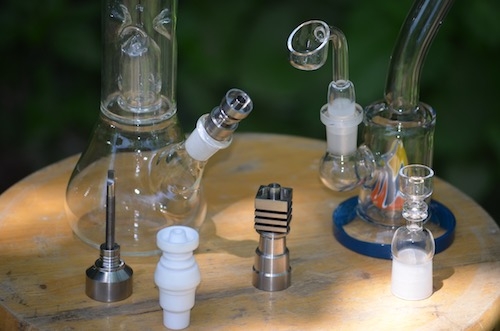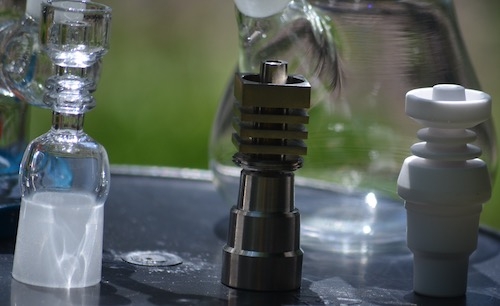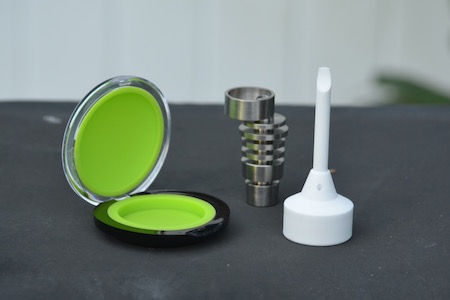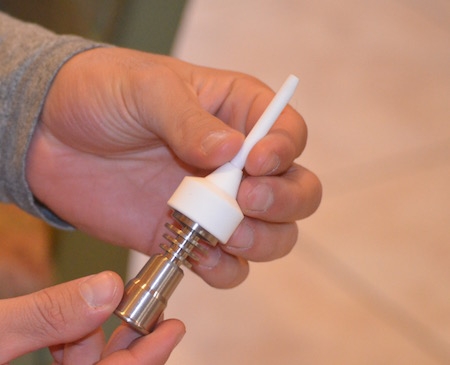How to Use a Domeless Nail - Best Dab Nail Tutorial
Read this post to learn about domeless nails from ceramic to titanium and quartz nails. We break down using the domeless nails plus key differences and other useful information about the popular dabbing tool.
Domeless Dab Nail Introduction
One of the most important aspects of a dabber’s setup is the type of nail you are going to use. With options such as glass, quartz, ceramic, domed, domeless, electronic, smaller, bigger, and more, it can be hard to find your ideal piece early on. Domed and domeless nails both have their own unique benefits to a dab rig, all based on your preferences and how you like to take your dabs. The domeless dab nail style is a newer trend, and for good reason as it is a very efficient and fun way to dab and get the most out of your concentrate.
Generally, most dabbers use domeless nails for a quicker and more efficient setting, letting you work smarter and not harder. Like domed nails, they’re made of a variety of materials but contribute uniquely to an oil rig.
It’s pretty obvious why dab nails are a great accessory if you’re a frequent dabber, and why they are widely considered to be a great dabbing option.
Step by Step Guide to Dabbing with a Dab Nail
There are many different kinds of nails, and each bring with the unique traits and benefits. Every dab enthusiast strives to have the best oil rig – it’s an art form in the community. Everyone has individual preferences, but there is one debate within the community that seems as if it will never be resolved: domeless nails vs. domed nails. There are numerous ways to consume your dabs, but perhaps the most important thing for the frequent user to consider is the many different pros and cons associated with different style of dab nails and rigs. Exploring these differences is critical to find your ideal rig.
1. Grab the wax with the dab tool and put a small amount on the end of the tool.
2. Heat the nail with the blowtorch for 30-40 seconds or until the glass or quartz is red hot.
3. Wait until the nail is at your desired temperature (depends on your preferences).
4. Place the end of the dabber into the domeless dab nail, and then wipe the melting wax into the plate and then cover with a carb cap.
5. Take your pull as the nail surface vaporizes the wax

Using the Domeless Dab Nail Variations
Generally, all nails are used in the same fashion. The main difference between different styles of nails are the way in which they utilize air flow and how the quality of the dab ends up when you take the hit. The general process for using any nail is more or less the same but the exact style or design can differ. Continue reading as we break down the nail variations available today.
Domed Dab Nails
The occasional dabber generally uses a domed nail in a rig. Domed nails are generally made out of titanium, ceramic, quartz, or glass, and are cheaper than most domeless nails. While there are many reasons to use a domed nail in your oil rig, there are a few downsides as well. If you’re new to dabbing with a rig, and a more patient cannabis user, then perhaps these cons will not bother you as much as it might a consistent smoker. Domed nails take much longer to heat up, and are less simple to dab. Since there is more to the nail itself, it is also more prone to accidents and breaks. Domed nails do capture vapor much better than domeless nails used without carb caps, and are just a more basic and simple package for newcomers and casual dabbers.
What is a bit of a drag about domed nails is the theatre of the whole dabbing performance that they require, which in this case is a multi-step process. First you have to heat the nail, then quickly get the dome overtop, and THEN you attempt the dabbing. In this time when you're fumbling for the dome, you're losing precious heat and also greatly increasing the risk of an accident occurring. This also results in more opportunities for accidents, burns, or any other type of incident involving very hot objects. Also, what's more, a dome is yet another glass piece you'll have to clean and maintain and constantly worry about misplacing or breaking. Domed nails definitely hold heat more efficiently and get the job done, but if done on a regular basis, can begin to result in accidents or an annoying amount of extra steps that e-nails and domeless nails cut out.

Domeless Dab Nails
Generally, frequent users use domeless nails for a variety of reasons. Like domed nails, they’re made of a variety of materials but contribute a unique set of benefits to your rig.
Dab nails are a great accessory for many reasons, and if you’re a frequent dabber, you are likely to think it is the superior version of the nail. The only cons for domeless nails are that they heat up faster (depending on thickness) and that they require use of a carb cap to capture all of the vapor created. These are very slight drawbacks, as carb cap dabs can be more effective and dabbed at lower temperatures for a smoother taste and feel.
E Nails
E nails are becoming increasingly popular due to the unparalleled efficiency they offer. With an e nail, you don’t need a blowtorch to get the nail hot, and because it is electric you can choose the temperature of the nail down to the exact degree, and keep at that temperature for as long as you want. Rather than guessing and repeatedly using a blowtorch for every dab, e nails allow you to save time and hit your dabs at the perfect temperature every time.
Quartz Nails
Many say quartz nails are their go-to choice for nail material. This is because quartz provides the best natural flavor, are very sturdy, and retain heat very well. Especially for domeless quartz nails, carb-cap dabs are great because the nail does not lose temperature between the initial dabbing and when you put on the carb cap. Quartz is sturdy, resilient, and one of the most popular choices among regular dabbers.
Ceramic Nails
Ceramic dab nails are well known for the way it can preserve the natural flavor of the wax, as well as its ability to very efficiently hold heat. In addition, they are also one of the more cost-effective options when it comes to nail materials. The only drawback to ceramic nails is that they are very fragile. Ceramic pieces have been known to break at the first accident they experience, so depending on your confidence in your ability to not be clumsy, keep this factor in mind!

Titanium Composite
Titanium is widely regarded as the iron man of nail materials. Compared to other materials such as glass, which can break much more easily especially when the glass used to make most nails is very thin. Titanium is a better candidate for those looking for less design and aesthetic and more durability; it is extremely strong and can never break. You are guaranteed that it will serve you for as long as you need it to without your having to worry about it breaking.
Titanium heats much better compared to glass. When you heat your nail, titanium will be able to retain much more heat and for longer periods of time compared to glass. Other than its great ability to retain heat, titanium also gets heated much faster and is much more durable.
Interchangeable or Universal Nails
Interchangeable dab nails are favorites in the community as it allows for you to use your favorite nails on a multitude of different pieces. All this means is that the nail can be unscrewed or taken apart and put back together with a stem of any size – which allows the Domeless nail to be compatible with many more dab rigs and stem sizes.

Tip for Using a Dab Nail
There are many ways to use a domeless nail, but one of the best kept secrets is the low-temp dab. In short, temperature should be looked as a continuum from too low to too high:
Low Temp Dabs
- More flavor, smoother, longer hits.
- The downside: Less vapor, milder in effect, may leave some concentrate behind.
High Temp Dabs
- Produces thick vapor, produces intense effects, all concentrate is consumed.
- The downside: Less flavor, harsh on lungs and throat, burns faster.
List of dabbing temperatures to aim for:
0 - 300°F: Too low
This will result in minimal vaporization of the available concentrate – you will not be consuming anywhere near all the contents of the wax you dropped on the nail. Expect the concentrate to leave a puddle of oil that produces little to no vapor.
315 - 450°F: Low temp dab
This is the sweet spot for vaporization of all cannabinoids while retaining maximum flavor. Dabbing at this temperature will produce a smooth hit that is easy on the lungs. The effects will be pleasant but milder than at hotter temperatures. These hits normally require a carb cap to finish off.
450 - 600°F: Medium temp
This is a nice middle ground for those seeking both stronger flavor and effect when dabbing wax. At this temperature, a mix of vaporization and flavor is experienced.
600 - 900°F: High temp
At this temperature, the dab nail may still be red hot and combustion is certain to occur. This will produce a harsh, intense hit with thick smoke. Most of the wax flavor will be lost at this temperature, resulting in a dab that tastes slightly burnt.
900 °F +: Burning the dab
Overall, timing how long you heat your dabs and judging the effects of them is the best way to find your sweet spot. Rather than just guessing every time, time it out, see how long you need to let it cool, and find your favorite temperature. Trial and error is the most effective way to find your ideal routine.
Related Blog Posts
E-Nails vs Dab Nails - A Helpful Guide
Blog Categories
- Home
- Industry News
- Vaporizer Reviews
- Dry Herb Vape Tutorials & FAQ
- Wax Pen Vape Tutorials & FAQ
- Oil Vape Pen Tutorials & FAQ
- Vaping Guides & Information
- Dabbing FAQ & Guides
- Smoking Pipe Tutorials
- NY Vape Shop Listicles
- Vape Pen Comparisons
- Vape Shop How To Articles
- Vape Shop Buyers Guide
- Vape Pen Basics
- Herb Grinder Reviews
- Dry Herb Vaporizer Reviews
- Oil Vape Pen Reviews
- Wax Pen Reviews
- Box Mod Vape Reviews